|
The
Navigators
Story of the Filming
The
following was written by Stephen Thomas, author of THE LAST NAVIGATOR.
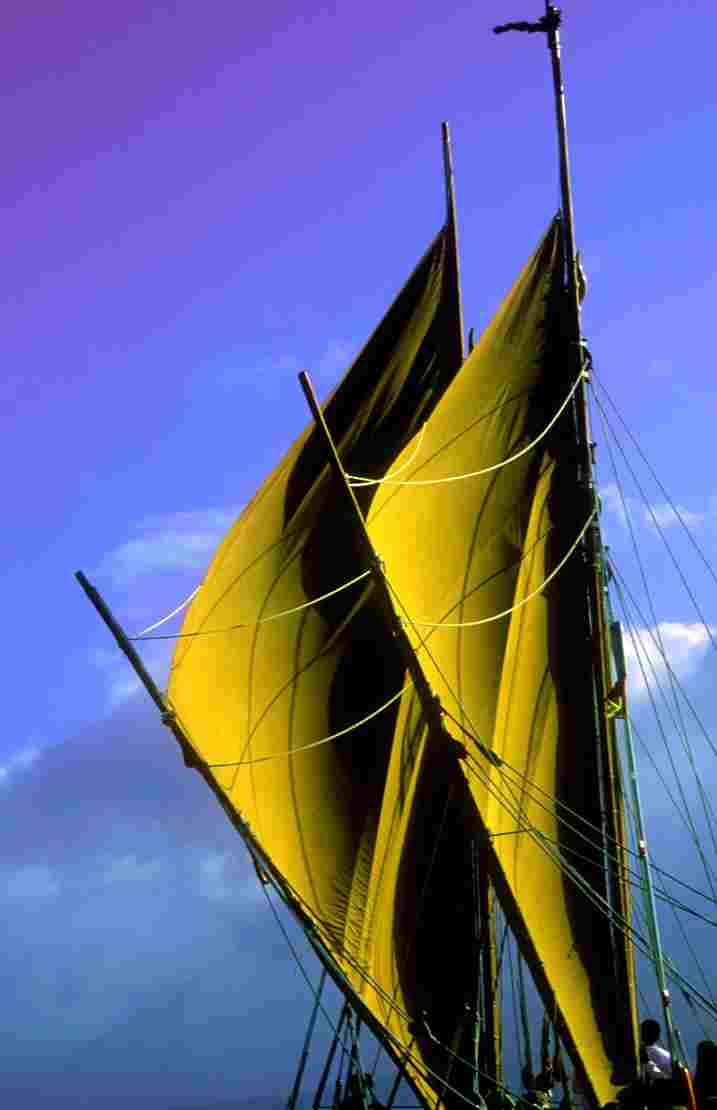 "The
Navigators," a one- hour documentary funded by Pacific Resources,
Inc., recreates one of the greatest navigational feats in human history:
the exploration and settlement of Polynesia by navigated voyages which
began more than 6,000 years ago. "The
Navigators," a one- hour documentary funded by Pacific Resources,
Inc., recreates one of the greatest navigational feats in human history:
the exploration and settlement of Polynesia by navigated voyages which
began more than 6,000 years ago.
THE
PRODUCTION TEAM
The producer of The Navigators, Dr. Sanford Low was formerly a producer/writer
for Public Television's "Odyssey" series. The film's credits
also include program consultant. Dr. Pat Kirch from the Bishop Museum;
cinematographer and director, Boyd Estus; film editor, Bill Anderson;
and associate producer and production manager, Sheila Bernard.
FILM
PRECIS
Shreds of mist shift and change, finally to reveal lush, tropical mountain
peaks. An ancient Hawaiian chant echoes: "Here is Hawaii, a child
of Tahiti." We see a 60-foot Polynesian voyaging canoe, sails brilliant
in the Pacific sunshine. These images are the first 30 seconds of the
documentary film, "The Navigators," anthropologist and film-maker
Dr. Sanford Low's documentation of the great voyages of the ancient
Polynesians. With major funding from Pacific Resources, Inc. (PRI),
and additional funding from the Arthur Vining Davis Foundations, and
the Hawaii Committee for the Humanities, Low tells the story of the
great voyages of Polynesia.
Ancient myths say that the Hawaiians, Tahitians and Maoris are one people,
and that they sailed across the forbidding Pacific to settle on those
widely scattered islands. If the myths have any basis in fact, then
the early Polynesians must have found their way across thousands of
miles of ocean. Polynesians must have been able to build, equip, man
and navigate vessels large enough and seaworthy enough to make these
passages of up to 3,000 miles.
To show us how such a culture would look. Low takes us to the tiny island
of Satawal, in Micronesia's Central Caroline Islands. Descended from
the same ancestors as the Polynesians, the people of Satawal still build
sea-going outrigger canoes, man them with sailors, and navigate them
throughout their widely scattered islands without maps or instruments
of any kind.
The Satawalese, and in particular, the navigator Mau Piailug, become
our guides, to whom we return again and again to bring the past alive.
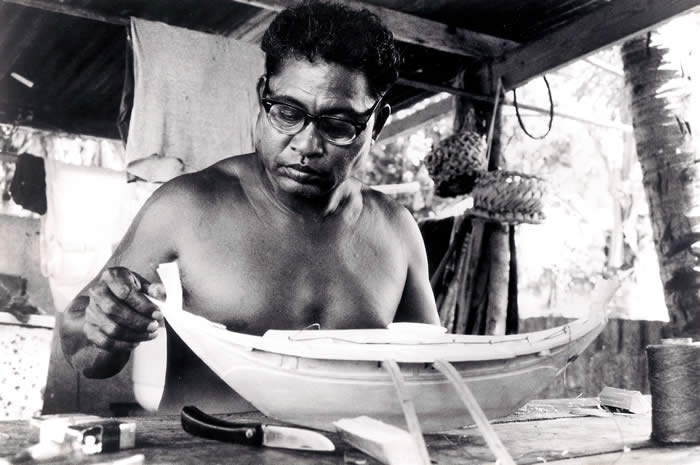
Mau Piailug creating model of his canoe
Steve Thomas Photo
Distinguished Bishop Museum scientists Drs. Patrick Kirch, Yosihiko
Sinoto and Roger Green show us how the early Polynesians ventured eastward
from their homeland in Island Southeast Asia down through the Solomon
Islands and out to Samoa, Tonga, and Fiji, the Cradle of Polynesia.
There they remained for a thousand years before making the great open
ocean voyages to the Marquesas, Tahiti, New Zealand and
Hawaii.
Back
on Satawal, in scenes never before filmed, we see Pialug passing on
to his people the knowledge of his forefathers, and finally we learn
that Piailug's ancient traditions are threatened. For in the end he
tells us: "After me, I am afraid there will be no more navigators."
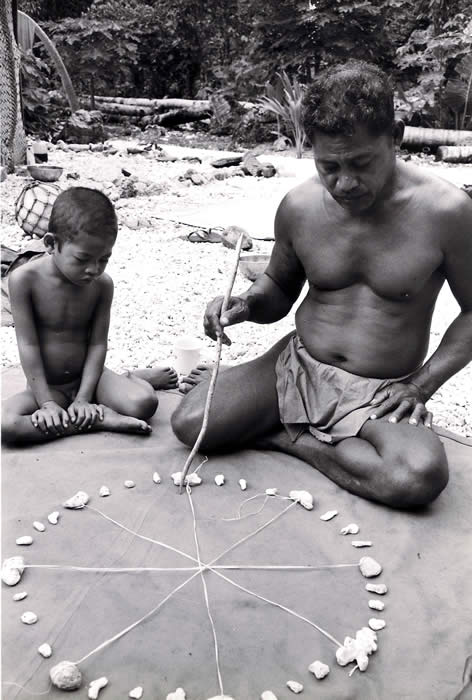
Mau Piailug using the star compass to teach navigation to his son
Steve Thomas Photo
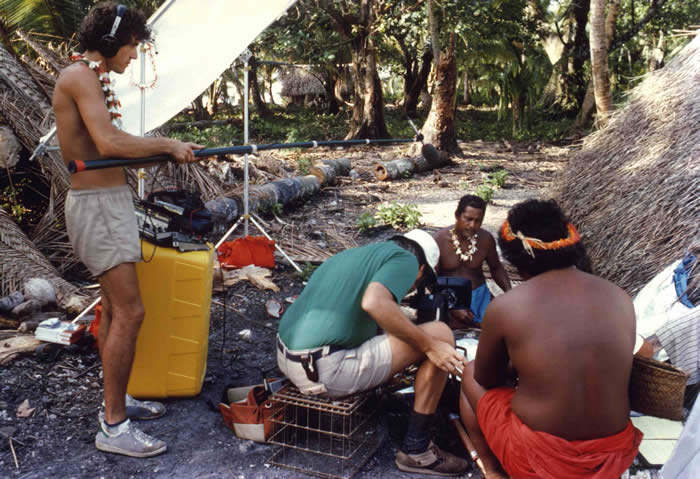
Eric Taylor (left), Boyd Estus, Mau Piailug, Translator
filming a key interview with Mau for The Navigators
POLYNESIAN
SEAFARING HERITAGE DOCUMENTED IN "THE NAVIGATORS"
Using only the wind, stars, flights of birds and other natural signs
to guide them, the ancestors of today's Polynesians sailed their hundred-foot
double-hulled canoes across a vast ocean area larger than Europe and
North America combined, on voyages that lasted for months.
In the remote Caroline Islands of the Pacific, an ocean which spans
one-fourth of the globe's circumference, are found the only remaining
non-instrument navigators, or palu. In Polynesia, despite great distance
and separation, scattered populations share an identical heritage, language
and customs.
In the past, many theories, including Thor Heyerdahl's "drift"
theory, were suggested to explain this phenomenon. Heyerdahl proposed
recently, that Polynesia was settled by colonists from South America
who drifted into the Pacific on primitive rafts. However, archaeologists,
linguists and other scientists have found evidence that confirms that
it was the remarkable navigational abilities of these early Polynesian
seafarers, first inhabitants of these islands, that allowed their culture
to spread. These new theories hold that the Polynesians sailed into
the Pacific from Island Southeast Asia, against winds and currents prevailing
in the Pacific.
Small Satawalese Proa
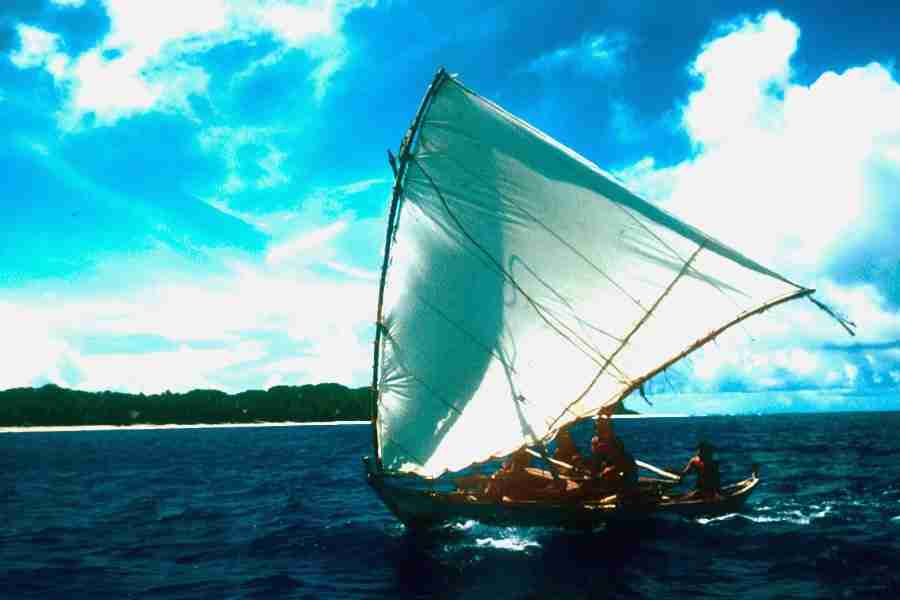 Dr.
Sanford Low spent three weeks on the tiny coral atoll of Satawal bringing
the past alive by recording the seafaring society that still thrives
there. Adding to "The Navigators" authenticity is island spokesperson
Mau Piailug, Satawal's last initiated palu, who takes viewers back in
history, as he skillfully sails the Hokule'a, a replica of the original
Polynesian navigators' huge canoes, 2,500 miles across the open sea.
Piailug finds his way from Hawaii to Tahiti, always on course, without
the benefit of sextant, compass or any other western navigational instrument. Dr.
Sanford Low spent three weeks on the tiny coral atoll of Satawal bringing
the past alive by recording the seafaring society that still thrives
there. Adding to "The Navigators" authenticity is island spokesperson
Mau Piailug, Satawal's last initiated palu, who takes viewers back in
history, as he skillfully sails the Hokule'a, a replica of the original
Polynesian navigators' huge canoes, 2,500 miles across the open sea.
Piailug finds his way from Hawaii to Tahiti, always on course, without
the benefit of sextant, compass or any other western navigational instrument.
In addition to celebrating one of the greatest seafaring accomplishments
in history, "The Navigators" reveals Polynesian life and travel
as it might have existed during the time of the great voyages, from
the birth of Christ to 1200 A.D.
"THE NAVIGATORS": STORY OF THE FILMING
Polynesia is a vast ocean area spanning nearly a fourth of the world's
surface, strewn with high volcanic islands and low coral atolls. The
distances between major island groups are great: Hawaii to Tahiti, 2,500
miles; Tahiti to New Zealand, 2,700 miles. Astonishingly, this huge
area is populated by people who share the same cultural heritage, with
language, customs and navigational skills that trace back to the same
origins.
The
Early Polynesian Seafarers
Historians and scientists now agree that the settlers of these widely
scattered islands came from the west, on intentionally navigated voyages
by large double-hulled canoes, in one of the most stunning seafaring
accomplishments of the human race.
The
Producer
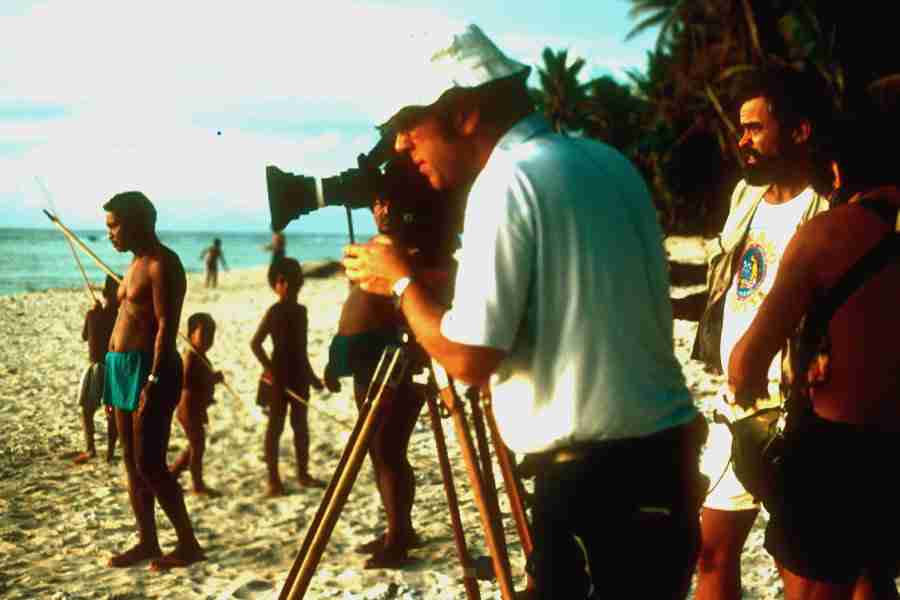 Anyone who has stood on a seashore braced against a stiff wind must
be awed by the thought of that mass of air moving steadily over miles
and miles of cold, dark sea, and must be grateful for a solid beach
and the warm earth. Surely the captains of the ancient Polynesian voyaging
canoes must have stood thus, before they departed. Film-maker Sanford
Low knew this feeling well-that of looking out across the water, and
back in time. He knew it first as chief diver for numerous underwater
archaeological excavations in the Mediterranean Sea and later as a watch
officer aboard a Naval vessel in the Pacific. From these experiences,
and because he is part Hawaiian, Low acquired both an intellectual and
a personal interest in making "The Navigators."
Anyone who has stood on a seashore braced against a stiff wind must
be awed by the thought of that mass of air moving steadily over miles
and miles of cold, dark sea, and must be grateful for a solid beach
and the warm earth. Surely the captains of the ancient Polynesian voyaging
canoes must have stood thus, before they departed. Film-maker Sanford
Low knew this feeling well-that of looking out across the water, and
back in time. He knew it first as chief diver for numerous underwater
archaeological excavations in the Mediterranean Sea and later as a watch
officer aboard a Naval vessel in the Pacific. From these experiences,
and because he is part Hawaiian, Low acquired both an intellectual and
a personal interest in making "The Navigators."
With his own funds he began the research in Hawaii. There he met the
Bishop Museum's Dr. Yosihiko Sinoto, who had excavated an ancient village
on Huahine in the Society Islands. Among other artifacts, Sinoto unearthed
the planks, mast and a steering paddle from a big sailing canoe, or
pahi. Sinoto quickly re-buried these treasures to prevent them from
disintegrating upon exposure to the air. "While I was talking with
Yosi," Low said, "I learned that he was returning to Huahine
within a few months to re-excavate and preserve the ancient canoe pieces."
Suddenly, a vital piece of Low's story was about to unfold and he had
to find a way to film it - fast.
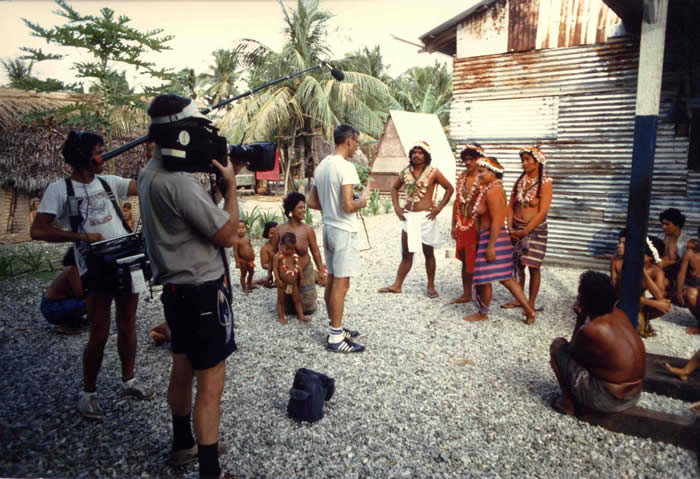
Filming a wedding on Satawal
Sam Low Photo
The
Funding
Low contacted PRI and explained the project. Enthusiasm was immediate
and Low was encouraged and supported by PRI's then vice president of
Public Relations, Philip H. Kinnicutt.
PRI Chairman and Chief Executive Officer James F. Gary commented, "For
a long time PRI has been looking for a project which would celebrate
the achievements of the Polynesian people and benefit the Hawaiian community.
Low's film offered us just such an opportunity."
PRI made a grant to Low for the filming phase of "The Navigators."
While carrying on with the planning, Low joined forces with KHET, the
Hawaii Public Television station, to solicit a grant from the Hawaii
Committee for the Humanities. He returned to Boston, where he received
word that the Arthur Vining Davis Foundations would also help fund the
project.
The
Team
In a matter of months Low's project had gone from initial research to
being fully funded. It was then January 1982. Low had to plan and organize
a major fuming expedition to remote sites in the Caroline Islands, Fiji,
The Society Islands and Hawaii. Moreover, he had to do it fast. The
spring sailing season in the Caroline Islands was only months away and
if he missed it he would have to postpone the shooting for a year-something
he couldn't afford to do.
Quickly Low assembled a team. Sheila Bernard, who had worked with him
on his previous PBS documentary, "The Ancient Mariners," was
named again as associate producer and production manager. Boyd Estus,
cinematographer of the Academy Award-winning documentary, "The
Flight of the Gossamer Condor," joined the expedition as co-director
and cameraman. Bill Anderson, editor for Nova, Odyssey, World and many
other PBS projects, would edit the film.
Special
Equipment for a Remote Site
On Satawal the team would be shooting in a location 600 sea miles from
the nearest airport and serviced by freighter on a wildly irregular
schedule. Whatever they needed would have to be brought with them. The
equipment and logistic requirements were formidable for such a remote
operation and much of the equipment had to be specially designed.
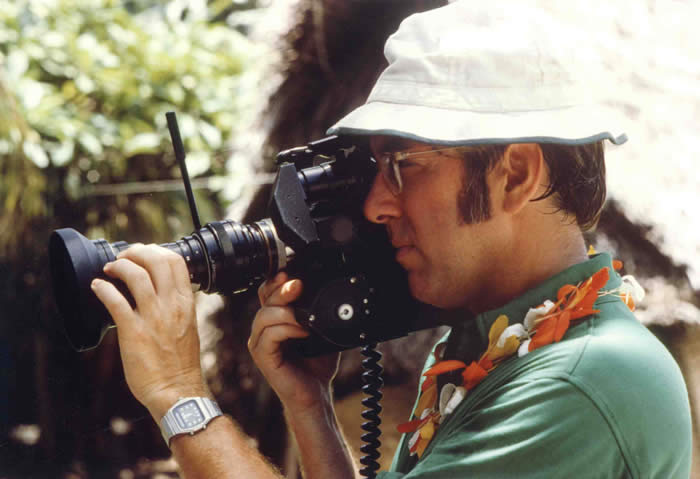
Boyd filming on Satawal
Sam Low Photo
Since they would be filming on small, wet outrigger canoes, some means
of keeping the camera dry had to Be devised. Estus designed a "parka"
for their two $40,000 Eclair 16mm cameras of the same black neoprene
divers use for their wet suits. For underwater shots Estus rented a
housing of metal pipe in which he placed a small, aircraft "gun"
camera. Since Low planned to document the traditional navigational instruction
ceremonies, which take place at night in the canoe house, he had to
bring special filming lights, filters and stands, and, as there is no
electricity on the island, a portable generator was needed. The generator
would have to be located far enough away from the filming so that the
highly sensitive sound equipment did not record its noise. Therefore,
they packed a quarter-mile of electrical cable. None of the crew spoke
Satawalese, so an interpreter would have to be found on the island.
To keep Low informed about what was being said as it was being filmed,
a complex system of radio-controlled microphones was designed by Estus
and sound-recordist Eric Taylor. The sound-recording equipment was connected
to a small radio transmitter which broadcast to the interpreter located
off-site. He translated the proceedings and transmitted them through
a special radio to Low, who, listening on headphones, could communicate
with Estus by a set of hand signals. All these systems had to be backed-up
with spares in case of a breakdown. This gear, together with 48,000
feet of film, tripods, lenses, a gyro-stabilizer for filming in heavy
seas, rubber boats, radios, camping gear, and food for the crew amounted
to some two tons-which would have to be landed on Satawal by small boat
through the surf. Estus designed and had constructed special waterproof
bags to keep their gear dry in case the boat overturned. Estus said:
"I've filmed on locations all over the world, but this one was
one of the hardest I've had to plan for-salt water is the enemy of any
delicate gear."
Low then had to charter a boat to get the crew to Satawal. The boat
would have to be big enough to carry crew and equipment and, since Satawal
has no harbor, be able to carry enough food, water and fuel to stand
offshore for the duration of the filming.
Already running behind schedule in May, Low had to find a crew who would
be willing to navigate the treacherous waters of the Caroline Islands
during typhoon season. After searching in Micronesia and Hawaii for
a month. Low finally found a 60-foot schooner-The Dorcas-captained by
Dan Wright and a crew willing to do the charter.
No sooner did the film crew arrive in Guam and stow their gear aboard
the schooner than three typhoons blew through the area, one after the
other. For two weeks they were pinned in harbor. This was the beginning
of a very tough and challenging period for Low. The delay was costing
him a thousand dollars a day. "But far more importantly,"
says Low, "I realized I had the safety often people on my hands.
If one of those typhoons had kissed us ... well . . .'
The two weeks in Guam were spent mostly in the weather hut at the U.S.
Naval Air Station. Estus installed a radio on the schooner and arranged
a network of operators to keep them informed daily of typhoon warnings
once at sea and on Satawal.
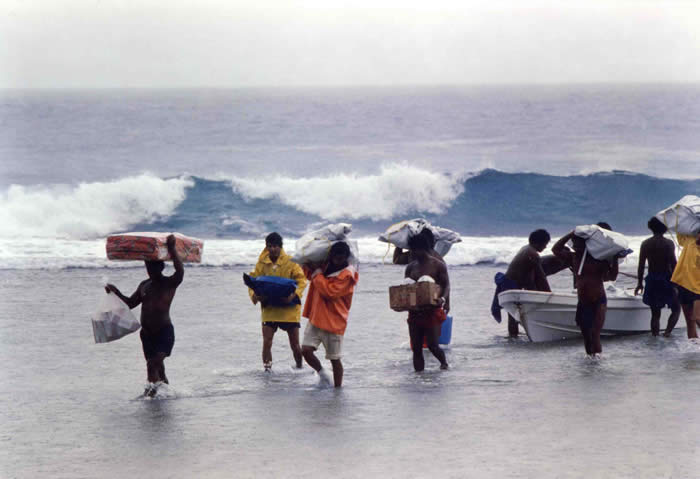
Film and camping gear arrives on Satawal - note the wave breaking on the reef. (Boyd Estus photo)
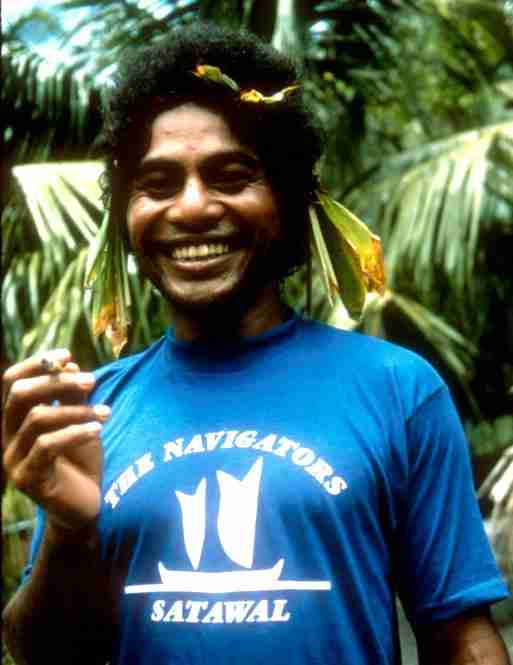 Satawal:
The Shoot Satawal:
The Shoot
On
Satawal, Low planned to film events in "real time," as they
happened. He was up at 5 each morning, trekking the village with Mau
Piailug, the navigator who became the central figure in the film. With
Piailug, he made arrangements for each day's filming. Despite interruptions
to the customary daily routine of the island, the Satawalese joined
wholeheartedly in the work of the film.
"They were remarkable!" exclaimed Low. "They skillfully
guided us through the crashing surf, helped lug our two tons of gear
ashore, fed us, housed us, held three feasts in our honor-they overwhelmed
us with their hospitality."
But it was the navigator, Mau Piailug, who took special pains to guide
the film crew every step of the way. He took Low and Estus into his
home and treated them as his sons-worthy, but needing the steady guidance
of a father.
At night Piailug schooled Low in the lore of the sky, which was handed
down to him through the generations, and which has guided him over thousands
of miles in the Pacific. Low came to realize that Piailug was fully
aware of the complexities of his film project. Having visited Hawaii
and Tahiti, and having gained national recognition for his navigation
of Hokule'a, the 60-foot replica of a Hawaiian voyaging canoe that sailed
from Hawaii to Tahiti, Piailug knew what the 20th .century was about
to overwhelm Satawal.
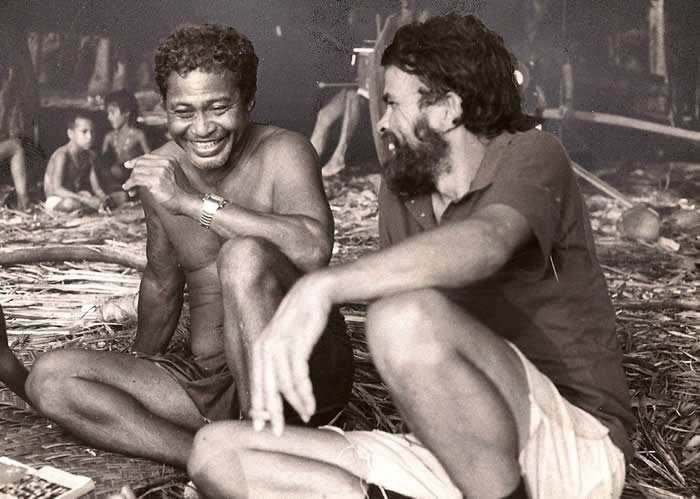
Mau and Sam take a break in Mau's canoe house
Sheila Bernard Photo
"I think Mau saw the film as a way to preserve the knowledge of
his fathers-his heritage as a navigator. On Satawal a navigator is a
teacher-more than a teacher, he is a community leader. He is bound by
an unspoken contract to pass on to the community what he knows."
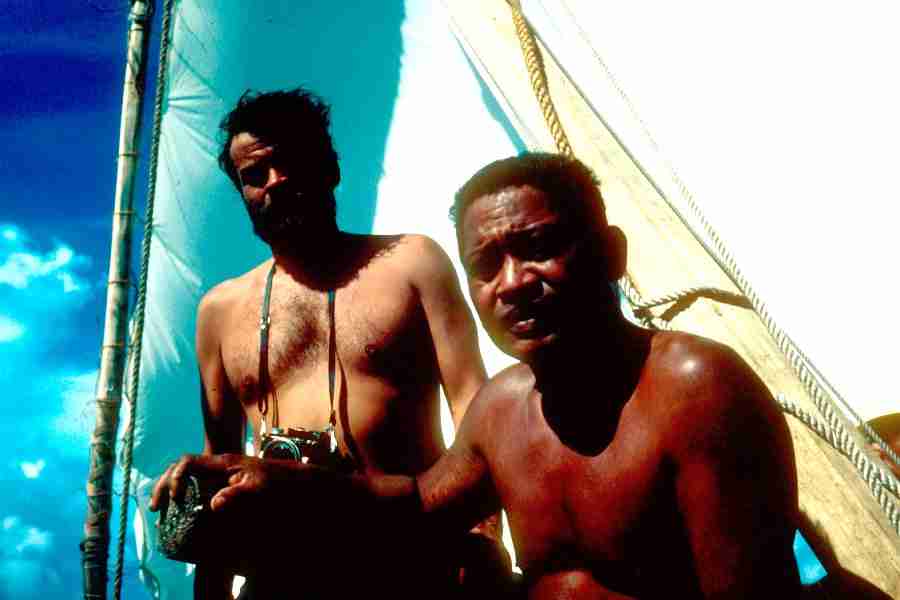 The day the film crew left, Piailug told Low: "I wanted you to
make this film because the world is changing. I may be one of the last
navigators. I hope that by your film, other people, the young people
on this island and those that have never heard of the navigators, will
understand what we know."
The day the film crew left, Piailug told Low: "I wanted you to
make this film because the world is changing. I may be one of the last
navigators. I hope that by your film, other people, the young people
on this island and those that have never heard of the navigators, will
understand what we know."
(Having filmed activities on the island as diverse as a wedding, canoe-building,
and a night-time canoe trip to a neighboring island, the film crew departed
on August 15, 1982 to complete the filming on Fiji and Hawaii. Three
weeks after Mau Piailug said goodbye, the production phase of the film
was completed. Low's work, however, was far from finished.
Post-Production
Back in Boston the footage was processed and printed, and the labor
of editing began. "This was the first time I was really worried,
said Low. I was suffering from a bad case of producer's
hangover. The images we came back with didn't match my preconceptions."
Editor Bill Anderson, however, fresh to the project, didn't share Low's
worries. "The images took me to a place and time I'd never seen
before," he said "I knew we had a good film on our hands."
After
six weeks of editing the film began to reveal itself. Low put it this
way: "It was as if we had a 200-pound ballerina on our hands: she
could dance-not well-but she was dancing, and she had to lose weight.
We had to do was put her on a diet."
"The
Navigators," reveals the art and science of Polynesian navigation
as never portrayed before. Some of the material, such as the teaching
sessions in the canoe house, have never been filmed. Other sequences
show breathtaking aerial and underwater shots. Low weaves the ethnographic
originality and physical beauty of the island setting into the story
of how the vast reaches of the Pacific were settled.

Sam resting at a marae (temple) on Huahine Island during filming of The Navigators. Sketch by cameraman Peter Hoving. |

 "The
Navigators," a one- hour documentary funded by Pacific Resources,
Inc., recreates one of the greatest navigational feats in human history:
the exploration and settlement of Polynesia by navigated voyages which
began more than 6,000 years ago.
"The
Navigators," a one- hour documentary funded by Pacific Resources,
Inc., recreates one of the greatest navigational feats in human history:
the exploration and settlement of Polynesia by navigated voyages which
began more than 6,000 years ago.


 Dr.
Sanford Low spent three weeks on the tiny coral atoll of Satawal bringing
the past alive by recording the seafaring society that still thrives
there. Adding to "The Navigators" authenticity is island spokesperson
Mau Piailug, Satawal's last initiated palu, who takes viewers back in
history, as he skillfully sails the Hokule'a, a replica of the original
Polynesian navigators' huge canoes, 2,500 miles across the open sea.
Piailug finds his way from Hawaii to Tahiti, always on course, without
the benefit of sextant, compass or any other western navigational instrument.
Dr.
Sanford Low spent three weeks on the tiny coral atoll of Satawal bringing
the past alive by recording the seafaring society that still thrives
there. Adding to "The Navigators" authenticity is island spokesperson
Mau Piailug, Satawal's last initiated palu, who takes viewers back in
history, as he skillfully sails the Hokule'a, a replica of the original
Polynesian navigators' huge canoes, 2,500 miles across the open sea.
Piailug finds his way from Hawaii to Tahiti, always on course, without
the benefit of sextant, compass or any other western navigational instrument. Anyone who has stood on a seashore braced against a stiff wind must
be awed by the thought of that mass of air moving steadily over miles
and miles of cold, dark sea, and must be grateful for a solid beach
and the warm earth. Surely the captains of the ancient Polynesian voyaging
canoes must have stood thus, before they departed. Film-maker Sanford
Low knew this feeling well-that of looking out across the water, and
back in time. He knew it first as chief diver for numerous underwater
archaeological excavations in the Mediterranean Sea and later as a watch
officer aboard a Naval vessel in the Pacific. From these experiences,
and because he is part Hawaiian, Low acquired both an intellectual and
a personal interest in making "The Navigators."
Anyone who has stood on a seashore braced against a stiff wind must
be awed by the thought of that mass of air moving steadily over miles
and miles of cold, dark sea, and must be grateful for a solid beach
and the warm earth. Surely the captains of the ancient Polynesian voyaging
canoes must have stood thus, before they departed. Film-maker Sanford
Low knew this feeling well-that of looking out across the water, and
back in time. He knew it first as chief diver for numerous underwater
archaeological excavations in the Mediterranean Sea and later as a watch
officer aboard a Naval vessel in the Pacific. From these experiences,
and because he is part Hawaiian, Low acquired both an intellectual and
a personal interest in making "The Navigators."


 Satawal:
The Shoot
Satawal:
The Shoot
 The day the film crew left, Piailug told Low: "I wanted you to
make this film because the world is changing. I may be one of the last
navigators. I hope that by your film, other people, the young people
on this island and those that have never heard of the navigators, will
understand what we know."
The day the film crew left, Piailug told Low: "I wanted you to
make this film because the world is changing. I may be one of the last
navigators. I hope that by your film, other people, the young people
on this island and those that have never heard of the navigators, will
understand what we know."